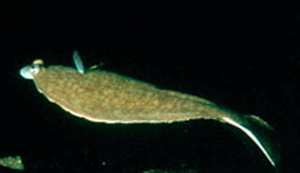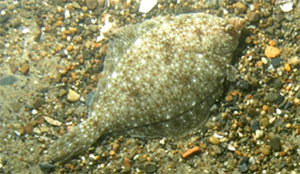
Yellowtail flounder are a thin-bodied flatfish. Both of its eyes are on the right side of its body.
High resolution (Credit: NOAA)
N.O.A.A. today announced that it will adjust the 2012 Georges Bank yellowtail flounder quotas for both commercial scallop and groundfish fisheries to preserve fishing opportunities for both industries.
This action - supported by both groups - transfers approximately 332,016 pounds of yellowtail quota from the scallop industry to the groundfish industry. As a result, this year's yellowtail quota for the groundfish fishery will increase by 69 percent to just over 811,301 pounds, allowing additional opportunities to harvest other groundfish stocks. The yellowtail quota for the Atlantic sea scallop fishery will decrease by 49 percent to approximately 346,126 pounds.
Although this is a reduction of yellowtail flounder bycatch quota for the sea scallop fishery, the revised allocation will provide enough yellowtail flounder to account for what is typically harvested by scallop fishermen in a year.
This action was recommended by the New England Fishery Management Council, with input from the Georges Bank yellowtail flounder working group, which includes representatives from the council's scallop and groundfish committees, council staff and NOAA. Environmental community members also expressed support for the adjustment.

Yellowtail flounder live on the ocean floor and especially prefer sandy bottoms.
High resolution (Credit: NOAA)
"The scallop and groundfish industries and NOAA's Fisheries Service have worked together to find an effective solution to a very difficult situation," said Samuel Rauch, deputy assistant N.O.A.A. administrator for NOAA's Fisheries Service. "This transfer would not be possible without cooperation between the 2 industries. It enables both fisheries to continue to operate, while still protecting the yellowtail resource."
The council also requested that N.O.A.A. remove accountability measures for the scallop fishery, which would close certain fishing areas in 2013 if the scallop fishery catches in excess of its 2012 yellowtail flounder quota. However, the groundfish fishery accountability measures would remain in place to protect the Georges Bank yellowtail flounder stock and prevent overfishing if the overall U.S. yellowtail flounder quota was exceeded during the 2012 fishing year.
N.O.A.A. intends to address the council's request for removing accountability measures in a separate rulemaking. As soon as the necessary technical analysis is complete, N.O.A.A. will publish a rule in the Federal Register proposing to remove the scallop fishery's accountability measure, as requested by the council.
NOAA's mission is to understand and predict changes in the Earth's environment, from the depths of the ocean to the surface of the sun, and to conserve and manage our coastal and marine resources. Join us on Facebook, Twitter and our other social media channels.

